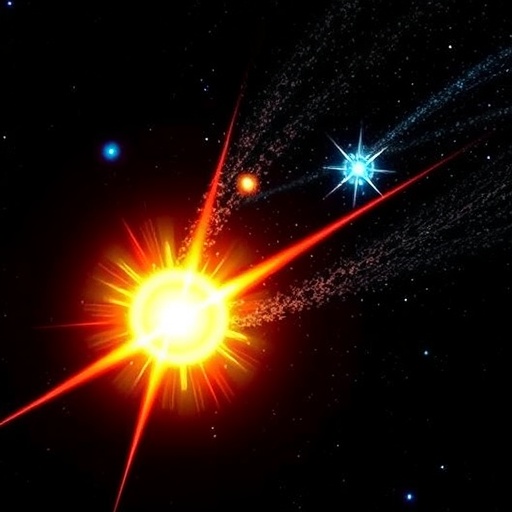In a groundbreaking advancement in high-energy astrophysics, an international team of researchers has revealed the first-ever detection of millisecond pulsations emanating from a gamma-ray burst, fundamentally reshaping our understanding of these cosmological phenomena. This discovery, spearheaded by scientists from The University of Hong Kong (HKU) in collaboration with Nanjing University and the Chinese Academy of Sciences’ Institute of High Energy Physics, unearths a hidden rhythm within the violent aftermath of a compact star merger, shedding light on the enigmatic central engines that power gamma-ray bursts (GRBs).
Gamma-ray bursts represent some of the most formidable explosions observable in the universe, capable of outshining the entire gamma-ray sky in fleeting moments. These bursts typically trace their origins to cataclysmic events such as the collision and merging of neutron stars or the terminal collapse of massive stars, both of which yield extreme physical conditions. For decades, the exact nature of the remnants responsible for generating these colossal energy outputs has remained murky, with debate centered on whether the core collapses directly into a black hole or forms a highly magnetized, rapidly rotating neutron star known as a magnetar.
On March 7, 2023, a unique gamma-ray burst labeled GRB 230307A was detected by China’s GECAM-B and GECAM-C satellites, alongside NASA’s Fermi Gamma-ray Burst Monitor. This exceptionally bright event, recorded as the second most luminous GRB to date, presented a paradox to astrophysicists due to its unusually extended duration of approximately one minute. This was in stark contrast to the generally accepted threshold of under two seconds for bursts originating from compact binary mergers, posing important questions about the underlying physical mechanisms at play.
Delving deep into over 600,000 high-resolution datasets sourced from the GECAM instruments, and corroborated by independent analyses of NASA’s Fermi data, the research team uncovered an extraordinary quasi-periodic oscillation (QPO) at an astonishing frequency of 909 Hz. This oscillation, which persisted for a mere 160 milliseconds, embodies the first direct signature of a newborn millisecond magnetar embedded within the sudden energetic jet unleashed during the GRB, providing a “heartbeat” that echoes the spin of this exotic stellar corpse.
The detection of this QPO represents a milestone because it connects theoretical predictions of magnetar-driven jets with observable signals. Millisecond magnetars—neutron stars rotating nearly a thousand times per second with magnetic fields trillions of times stronger than Earth’s—have long been posited as potential central engines fueling the brightest cosmic explosions through Poynting-flux dominated jets. These jets carry most of their energy in magnetic fields rather than matter, and their evolving asymmetry briefly imprints a periodic signal onto the escaping gamma rays, visible only within a narrow temporal window.
Professor Bing Zhang of HKU, a pioneering theorist who proposed many aspects of the magnetar-jet model over a decade ago, explained the transient nature of this signal: “The rapid spin of the magnetar modulates the gamma-ray emission, but the jet’s symmetry extinguishes the pulsations swiftly. This fleeting 160-millisecond window afforded us an unprecedented glimpse into the inner workings of the GRB’s central engine.” Such detailed observation confirms magnetars’ roles as powerful cosmic dynamos rather than the previously assumed immediate collapse into black holes.
This discovery marks a paradigm shift in the astrophysics community’s approach to interpreting GRB central engines. Previously, magnetar involvement had only been inferred through indirect clues derived from long-term afterglow light curves or theoretical frameworks lacking direct observational validation. The newly found millisecond pulsations grant astronomers a direct probe into the nascent stages of these stellar remnants, unlocking information about their spin rates, magnetic field strengths, and jet properties in real-time.
Beyond illuminating the physics of gamma-ray bursts, the implications extend into the burgeoning field of multimessenger astronomy. Detecting pulsations from newborn magnetars enables the correlation of electromagnetic signals with gravitational wave observations from compact object mergers, providing a more comprehensive narrative of these violent events. This synergy enhances our capacity to study extreme states of matter under conditions unattainable on Earth, refining constraints on neutron star equations of state and magnetic field evolution.
Looking forward, the research consortium plans to systematically search for similar pulsations in future bright GRBs. With next-generation space observatories and gamma-ray detectors on the horizon, the sensitivity to uncover such short-lived signals will improve dramatically. Each newly captured “heartbeat” will help construct a statistical understanding of magnetar formation rates, the conditions leading to the launch of relativistic jets, and how these processes influence galaxy evolution and heavy element synthesis across cosmic time.
The discovery also underscores the technological achievements embodied by the GECAM satellite mission, developed under the Chinese Academy of Sciences’ Strategic Pioneer Program on Space Science. The joint observational power of GECAM-B, GECAM-C, and NASA’s Fermi instruments exemplifies the importance of international collaboration in unlocking the universe’s most profound secrets. Such partnerships maximize the temporal and spectral coverage necessary to detect ephemeral astrophysical phenomena embedded within massive datasets.
In conclusion, the unveiling of millisecond pulsations during GRB 230307A not only confirms the existence of newborn magnetars powering some of the universe’s brightest explosions but also paves the way for a new epoch in high-energy astronomy. As these compact remnants reveal their cosmic “heartbeats” through gamma-ray emissions, scientists inch closer to comprehending the fundamental processes governing stellar death, neutron star formation, and the dynamic interplay of gravity and magnetism at extremes. This breakthrough heralds an exciting frontier, promising revelations that will challenge and enrich our cosmic perspective for decades to come.
Subject of Research: Not applicable
Article Title: Evidence for a brief appearance of gamma-ray periodicity after a compact star merger
News Publication Date: 19-Sep-2025
Web References: http://dx.doi.org/10.1038/s41550-025-02649-w
References: Nature Astronomy journal article, DOI: 10.1038/s41550-025-02649-w
Image Credits: Illustration: Yuja Tian and Yuting Wu, Nanjing Zhijiao Cloud Intelligent Technology Co., Ltd.; Scientific concept guidance: Runchao Chen and Binbin Zhang, Nanjing University
Keywords
Space sciences, Astronomy




